Exotic Herbs of Southeast Asia's Cuisine: A Culinary Journey Through Unique Ingredients
 |
Exotic Herbs of Southeast Asia's Cuisine |
The Exotic Pantry: Unveiling the Unique Herbs of Southeast Asian Cuisine
Welcome to a culinary journey where we unlock the secrets of the exotic pantry that defines Malaysian and Southeast Asian cooking. From the vibrant markets of Malaysia to the bustling streets of Thailand & Indonesia, a treasure trove of unique herbs, spices, and ingredients awaits, ready to transform your cooking into an authentic feast for the senses. In this post, we'll explore these culinary jewels, their uses, and how they contribute to the rich, complex flavours characteristic of this region's dishes.
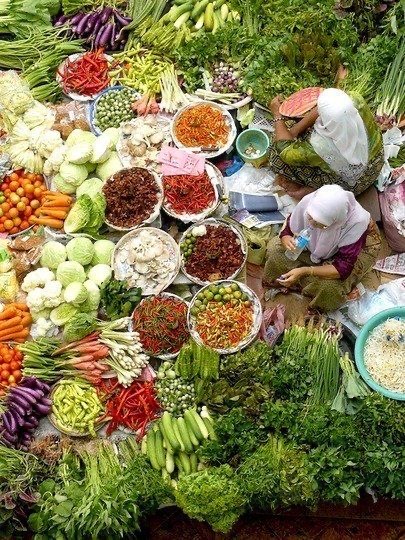 |
| Explore the Bustling Pasar Pagi: Malaysia's Morning Market |
My journey with these herbs and spices began with a simple spark of curiosity that ignited into a full-blown culinary adventure. I made it my mission to uncover the secrets behind each locally-used ingredient, immersing myself in reading about them and then embarking on expeditions to the bustling local markets. Bringing these treasures back home, I delved into my kitchen, experimenting with Malaysian, Thai, and Indonesian dishes. The results? Absolutely phenomenal!
As I reminisce, I'm amazed at how meticulously I honed my skills in mastering the flavours of these cuisines. And guess what? I can't wait to share some of my top recipes from "Essence of Life - Food," where these ingredients take centre stage. Oh, and let's not forget my little touch of love – I've taken to oven-drying these goodies, ensuring that even while my daughter is away studying in Georgia, she can still whip up her favourite Malaysian delights whenever she wants a bite of it.
Serai (Lemongrass) - A Tale of Discovery in Culinary Adventure

Delve into the Aroma of Serai: Lemongrass

Delve into the Aroma of Serai: Lemongrass
The revelation came when I moved to Malaysia and observed my neighbour uprooting lemongrass from our front yard. Discarding the leaves and keeping the stalks, she shared that this was a prized ingredient in her cooking repertoire. My curiosity was piqued, leading me from astonishment to fascination. My initial experimentation was modest – adding it to Maggi Noodles Soup on a friend's suggestion. This simple twist transformed the humble noodle soup into something exotic, hinting at the vast culinary landscape I had yet to explore.
|
|
As my culinary journey deepened, so did my relationship with lemongrass. From the spicy tang of Tom Yum Soup to the aromatic complexity of Thai Green Curry, the herb became a staple in my kitchen.
Each dish, whether it was the comforting Sayur Lodeh, the vibrant Indonesian Prawn Curry, or the intricate Nyonya Prawn Curry or Ayam Masak Merah or Rendang,tells a story of cultural fusion and personal culinary expedition. Lemongrass, with its lemony zest and subtle minty undertones, had not just enriched my dishes but had woven itself into the fabric of my culinary identity.
In embracing lemongrass, I embraced a world of flavour and tradition, discovering the essence of Southeast Asian cuisine. It's a reminder of how food connects us to places, people, and memories, turning simple ingredients into bridges between cultures.
Galangal/Lengkuas: Siamese Ginger

Unlock the Flavours of Thai Ginger (Galangal): Southeast Asia's Culinary Gem

Unlock the Flavours of Thai Ginger (Galangal): Southeast Asia's Culinary Gem
Galangal(Lengkuas), often referred to as ginger's more citrusy cousin, is a rhizome that holds a special place in Asian, Southeast Asian and North East Indian cooking. Its peppery and spicy notes, coupled with a zesty bite and a hint of pine, make it a distinctive ingredient that adds depth and complexity to dishes. While galangal may not be as ubiquitous as ginger, its unique flavour profile makes it well worth seeking out. Available in dried, powdered, and fresh forms, it offers a versatile addition to your culinary arsenal.
|
|
Though ginger and galangal share similarities and are used in similar ways, galangal boasts its own nuances that set it apart. It is one most common ingredient in the cuisines of many countries, including Cambodia, Thailand, Indonesia, Malaysia, Vietnam, Singapore, and Laos. Each culture infuses galangal into its dishes, imparting a signature flavour that reflects the region's culinary heritage.
From the fiery curries of Thailand to the aromatic soups of Indonesia, galangal plays a starring role in countless recipes, lending its unique taste and aroma to each dish. Its versatility knows no bounds, making it an indispensable ingredient in Southeast Asian kitchens and beyond.
Whether you're simmering a fragrant Thai Tom Yum Soup or crafting a bold Malaysian Rendang , galangal adds a layer of complexity that elevates your culinary creations to new heights.
Daun Limau Parut (Kaffir Lime Leaves): Citrusy Fragrance with a Hint of Spice
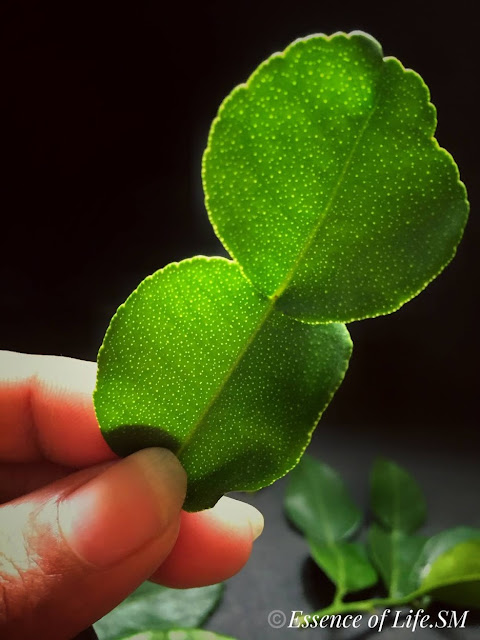
Dive into the Fragrance of Kaffir Lime Leaves (Limau Purut): Southeast Asia's Zesty Treasure

Dive into the Fragrance of Kaffir Lime Leaves (Limau Purut): Southeast Asia's Zesty Treasure
Kaffir lime leaves Daun Limau Parut, (as they are called in Malay),these leaves are a versatile addition to any kitchen. with their citrusy fragrance with a hint of floral and subtle spice, are an essential ingredient in Asian, Southeast Asian, and Indian cuisines. Unlike regular lime leaves, Kaffir lime leaves possess a distinct aroma that elevates dishes with its refreshing zest and aromatic complexity. Kaffir lime leaves are easily recognizable by their distinctive appearance. With dark green, double-segmented leaves that boast an hourglass shape, they add a touch of elegance to any dish. They add a refreshing and invigorating element to soups, curries, and stir-fries, infusing each dish with a burst of freshness that tantalizes the taste buds.
While Kaffir lime leaves may not be as readily available as other herbs, their unmistakable aroma and flavour make them well worth seeking out. Whether sourced fresh, dried, or frozen, they lend a bright and fragrant touch to a wide range of dishes, from Thai Tom Yum Soup to Indonesian Rendang adding depth and complexity to everything from curries and salads to desserts and beverages.
Found across Southeast Asia, Kaffir lime leaves are a staple in the culinary traditions of Thailand, Indonesia, Malaysia, and beyond.
|
|
In Thai cuisine, Kaffir lime leaves are often paired with lemongrass and galangal to create aromatic curry pastes and soups. They're a game-changer in Thai Green Curry recipe, offering a burst of freshness with every bite. In Indonesian cuisine, they are used in Rendang, Prawn Curry and Gulai Ayam, enhancing the richness and depth of these iconic dishes.
To prolong their freshness, wrap them in paper towel and store them in a plastic container or ziplock bag, where they can last for 2 – 3 weeks. Alternatively, freeze them in cling wrap for up to a few months, though the aroma may not be as intense.
Daun Pandan (Pandan Leaves): A Fragrant Tale of Discovery

Experience the Aroma of Pandan Leaves (Daun Pandan): Southeast Asia's Fragrant Elixir

Experience the Aroma of Pandan Leaves (Daun Pandan): Southeast Asia's Fragrant Elixir
My journey with pandan leaves began with a chance mention by my brother's friend during my college days, who claimed our neighbour(in my hometown in India) used them in cooking. At the time, I brushed it off as idle chatter, never realizing the aromatic treasure that lay hidden within those vibrant green leaves.
It wasn't until a visit to an acquaintance's home(in Malaysia), where Pandan Leaves(Daun Pandan) were knotted and added to rice for Nasi Lemak, that I truly understood their magic. As the fragrant steam wafted from the pot, I realized that pandan leaves had the power to transform humble rice into a fragrant and aromatic delight. It was a revelation that left a lasting impression on me.
My mother, always one to embrace new culinary discoveries, became enamored with pandan during her visit in Malaysia. During her evening walks around the neighborhood, she would forage for pandan leaves, delighting in their intoxicating aroma. I still remember her keeping a few leaves near her bed, much to my father's amusement, who jokingly complained about her newfound obsession.Back home in India, my mother went to great lengths to source a pandan bush, determined to bring a piece of Malaysia with her.
|
|
When pandan leaves aren't readily available, I turn to pandan extracts, ensuring that their vibrant flavour is never far from reach. And let's not forget the unexpected delight of Pandan fried chicken, a Thai delicacy that combines the fragrant aroma of pandan with the crispy goodness of fried chicken.
Kunyit (Turmeric Roots): A Golden Touch in Southeast Asian Cooking

The Golden Goodness of Turmeric Roots: Southeast Asia's Treasure

The Golden Goodness of Turmeric Roots: Southeast Asia's Treasure
My journey with turmeric roots began with a humble discovery in my own kitchen. While familiar with the powdered form of this vibrant spice, it wasn't until I stumbled upon its fresh counterpart that I truly appreciated its culinary magic.
Growing up, turmeric was a staple in my family's spice cabinet, reserved for adding warmth and colour to curries and rice. However, it wasn't until I moved to Malaysia that I encountered turmeric roots in their natural form. As I perused the local markets, I was captivated by the knobbly, golden rhizomes, each promising a burst of flavour and aroma.
My fascination deepened when I learned of turmeric roots' significance in Southeast Asian cooking. From Thailand to Indonesia, Malaysia to Vietnam, turmeric roots are a cornerstone of the region's culinary heritage. They lend their earthy, peppery flavour to everything from curries and stir-fries to marinades and sauces, infusing each dish with a golden hue and a depth of flavour that is truly unforgettable.
|
|
But turmeric roots aren't just prized for their culinary prowess. They also boast a range of health benefits, from their anti-inflammatory properties to their antioxidant-rich content. In traditional medicine, turmeric has long been used to alleviate ailments and promote overall well-being, making it a true powerhouse ingredient in both the kitchen and the medicine cabinet.
Whether grated into a curry paste, steeped into a fragrant tea, or converted into a vibrant spicy pickle, turmeric roots are a versatile addition to any cook's repertoire. So, the next time you find yourself in the kitchen, consider adding a touch of turmeric roots to your culinary creations. Not only will you be adding depth and complexity to your dishes, but you'll also be honouring a centuries-old tradition that celebrates the vibrant flavours of Southeast Asia.
Daun Kunyit (Turmeric Leaves): A Touch of Tradition

Turmeric Leaves (Daun Kunyit): Exploring the Aromatic Herb of Southeast Asia

Turmeric Leaves (Daun Kunyit): Exploring the Aromatic Herb of Southeast Asia
Turmeric leaves, with their vibrant green hue and subtle earthy aroma, are a cherished ingredient in Southeast Asian cuisine. My introduction to turmeric leaves in cooking came through two iconic dishes: Rendang and Nasi Kuning.
While making Rendang, a rich and fragrant Indonesian stew, turmeric leaves impart a distinct aroma that elevates the dish to new heights. As the slow-cooked meat simmers in a medley of spices and coconut milk, the aroma of turmeric leaves infuses every bite, creating a symphony of flavours that dance on the palate.
|
|
Similarly, in Nasi Kuning, or "yellow rice," turmeric leaves play a vital role in both flavour and presentation. The leaves are often used to wrap the rice before steaming, imparting a subtle earthiness and vibrant colour to the dish. The resulting Nasi Kuning is not only a feast for the senses but also a centerpiece of celebration and togetherness in many Southeast Asian cultures.
In my culinary journey, turmeric leaves are synonymous with tradition and flavour. Turmeric leaves hold a unique place in Malaysian & Indonesian culinary culture, yet their usage is not limited to this region alone. Surprisingly, I have never encountered the culinary usage of this item in South Indian cooking. However, during Pongal, the harvest festival, turmeric plants, along with their roots and leaves, are traditionally tied around the mouth of the Pongal Pot, symbolizing abundance and prosperity. Moreover,in Goa, there's a delightful sweet dumpling dish called Patholi where turmeric leaves play a significant role in imparting their subtle aroma to the dish.
Beyond their culinary uses, turmeric leaves also hold cultural significance. In traditional medicine, they are believed to possess medicinal properties and are used in herbal remedies for various ailments. Additionally, turmeric leaves are often used in religious ceremonies and rituals, symbolizing purity and prosperity.
Bunga Kantan(Ginger Torch Flower): A Culinary Revelation

Ginger Torch Flower (Bunga Kantan): Exploring the Exotic Ingredient of Southeast Asia

Ginger Torch Flower (Bunga Kantan): Exploring the Exotic Ingredient of Southeast Asia
My first encounter with Bunga Kantan, or the ginger torch flower, was a revelation in Southeast Asian cuisine. It happened during a dinner outing where I was introduced to the tantalizing flavours of Nyonya Style Tiga Rasa Steamed Fish. Little did I know, the unique taste that lingered on my palate was courtesy of the ginger torch flower.
Intrigued by this unfamiliar ingredient, I embarked on a quest to learn more. Researching online and noting down its Malay name, I made it a mission to seek out this elusive flower. It wasn't long before I found myself wandering through the bustling aisles of the local wet market, eyes peeled for a glimpse of Bunga Kantan.
Finally spotting it among the vibrant array of herbs and spices, I eagerly purchased a flower, a beautiful lotus like flower, eager to recreate the flavours of Nyonya Style Tiga Rasa Steamed Fishin my own kitchen. That afternoon, as I prepared the dish at home, the aroma of Bunga Kantan filled the air.
|
|
Since that day, Bunga Kantan has held a special place in my pantry, its unique flavour and aroma adding depth to a variety of Southeast Asian dishes. Whether used in traditional recipes or as a creative twist in my own culinary creations, it never fails to captivate the senses and evoke memories of culinary adventures past.This floral gem infuses salads and Sambals with a spicy, aromatic flavour. It's the secret ingredient in my Asam Laksa and in Nyonya Style Curries lending the dish its distinctive, tantalizing taste.
Bunga Telang (Butterfly Pea Flower): Nature's Vibrant Blue Treasure
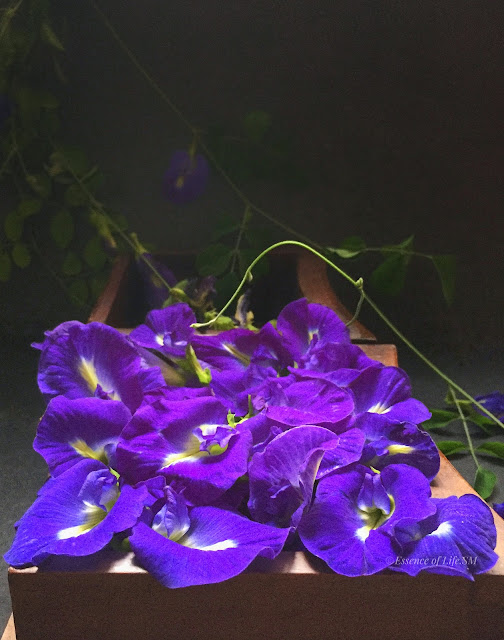
The Vibrant Blue Beauty of Butterfly Pea Flower (Bunga Telang): Southeast Asia's Floral Wonder

The Vibrant Blue Beauty of Butterfly Pea Flower (Bunga Telang): Southeast Asia's Floral Wonder
Butterfly Pea flower, with its striking indigo hue and delicate petals, is a botanical wonder that adds both visual allure and subtle flavour to a variety of dishes and beverages. My fascination with Butterfly Pea flower began with the flower and I always had a bush of this creeper in my garden. Later, using the flowers in my dishes & teas, drying it to store it up for later use, has become a routine in my kitchen. Its inclusion in Nasi Bunga Telang and traditional Nyonya Kuihs added an allure to the dishes.
|
|
In Nasi Bunga Telang, or "blue pea flower rice," Butterfly Pea flower infuses the rice with its vibrant blue colour, transforming a simple dish into a feast for the eyes. The rice, steamed with Butterfly Pea flower-infused water, takes on a mesmerizing shade of blue. Beyond its visual appeal, the flower imparts a subtle earthiness along with the pandan leaves added to the rice, enhancing its flavour and aroma.
Similarly, in Nyonya Kuihs such as Pulut Tai Tai, Kuih Lapis, and Kaya Kuih, Butterfly Pea flower is used for its vibrant hue, making the kuihs visually appealing and it wonderfully complements with the richness of coconut milk and the sweetness of palm sugar.
Butterfly Pea flower's versatility extends beyond the realm of traditional dishes, finding its way into teas, cocktails, and desserts around the world. Its stunning blue colour makes it a popular choice for colourful beverages and decorative garnishes.
Beyond its culinary uses, Butterfly Pea flower is also valued for its medicinal properties and health benefits. Rich in antioxidants and known for its calming effects, it has been used for centuries in traditional medicine practices across Southeast Asia.
Daun Selasih -Bai Horapa(Thai Basil): From Sacred Leaves to Culinary Delight

Thai Basil: A Culinary Bridge Between Cultures

Thai Basil: A Culinary Bridge Between Cultures
Known as Rama Tulsi in India, Thai Basil holds a revered spot in households for its spiritual significance, often found in gardens and used in prayers. Its seeds, popularly used in refreshing drinks like lemon sharbath and falooda, are known for their cooling properties. However, my culinary exploration in Malaysia unveiled its significant role in cooking, especially within Thai cuisine, marking a delightful fusion of culture and taste.
Thai Basil, known as 'Bai Horapa' in Thai, stands out with its unmistakable aroma and a hint of spice that sets it apart from its more common cousin, Sweet Basil. Thai Basil is celebrated for its unique flavour profile, which has made it a cornerstone in various dishes like Pad Kra Pao (Thai Basil Chicken), Thai Green Curry, Thai Red Curry, Thai Basil Fried Rice. Thai Pumpkin Curry etc.,
|
|
The journey from Rama Tulsi to discovering its use in Thai cuisine also illuminated the differences between Thai Basil and its Italian counterpart. Italian Basil, or Sweet Basil, is known for its large, soft green leaves and a sweeter, milder flavour that's quintessential to Mediterranean dishes like pesto, pasta, and salads. On the other hand, Thai Basil has a sturdier leaf structure, a spicier flavour profile with hints of anise and licorice, and is more resilient to cooking, making it ideal for the high heat of stir-fries and soups predominant in Southeast Asian cuisine.
Daun Sup (Chinese Parsley): The Fragrant Essence of Asian Cuisine

Daun Sup: The Herb of Freshness

Daun Sup: The Herb of Freshness
Daun Sup, known in English as "Chinese celery or Asian celery", is a staple herb in Southeast Asian cooking, revered for its aromatic flavour that's more pronounced than its Western counterpart. This slender, leafy herb is a key ingredient in broths, soups, and salads, bringing a burst of freshness and a hint of peppery spice to every dish it graces.
My personal journey with Daun Sup began in the bustling markets of Malaysia, where the herb's look deceived into buying it thinking that it was Coriander Leaves. So similar are its look with vibrant green leaves, but distinct in its aroma. As the name suggest, the herb lends a depth of flavour to traditional broths and soups, infusing it with a freshness that was both uplifting and comforting.
In Southeast Asian cuisine, Daun Sup is not just a flavour enhancer but a key ingredient that brings balance and harmony to dishes. It's commonly used in clear soups and in salads. I use them while cooking Mee Rebus and in Maggi Soup as a garnish.
|
|
For those looking to incorporate Daun Sup into their cooking, it's worth noting that this herb is best used fresh. Its delicate leaves and stems can be chopped finely and added towards the end of the cooking process to preserve its aroma and flavour. Whether it's used as a garnish, or simmered in soups, Daun Sup is a testament to the wonders of Asian herbs and their ability to elevate the dining experience.
Daun Kesum(Vietnamese Coriander): A Fragrant Herb

The Laksa Leaf - Unlocking the Aromatic World of Daun Kesum:

The Laksa Leaf - Unlocking the Aromatic World of Daun Kesum:
































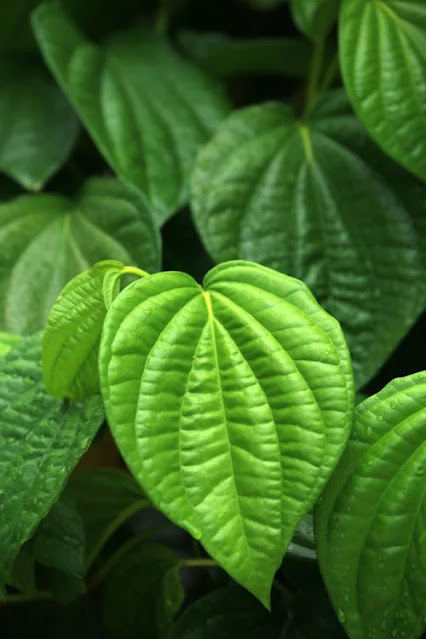



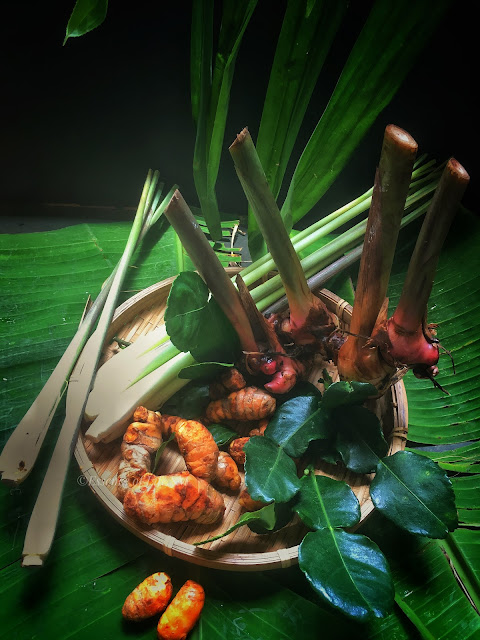








0 comments